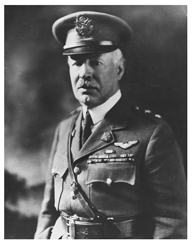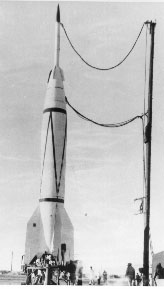
I n M a r c h o f 1 9 4 9 ,
the Titusville Star Advocate published a small editorial speculating that a new long-range launch site might be developed at Cape Canaveral. Only two months later President Truman authorized a 3,000-mile test range to be built, with the headquarters at the old Banana River NAS, soon to be renamed Patrick Air Force Base.
Late in the same year another bill was signed to fund the project and Banana River headquarters of the new rocket site was renamed the Joint Long Range Proving Ground. As the nation’s first long-range missile test center, the new proving ground was intended to serve as a joint facility for the various branches of the armed forces.
The decision to develop a missile proving ground with headquarters in Brevard County was made simultaneously with Soviet advances in nuclear technology. It is ironic that this new arm of American defense originated in Russia. In 1903, a Russian school teacher, Konstantin Tsiolkovsky (Ziolkovsky), first proposed a way to achieve space flight with rockets using liquid oxygen and hydrogen.
The schoolteacher’s theory was first tested in America by a professor from Clark University. After ten years of research, Dr. Robert H. Goddard designed, built, and launched America’s first liquid propelled rocket in 1926. Goddard’s research continued throughout the 1930s, but his basic design remained unchanged. His first tiny craft was the direct ancestor of the German and early U.S. spacecraft.
Hitler’s scientists perfected Goddard’s rocket technology with their V–2 advancements during the 1940s. The U.S. captured one–hundred of the German weapons in 1945, giving an initial boost to America’s space program. The U.S. experimented with the German missiles, initially launching them from ships in the Atlantic and from the White Sands Proving Ground.
When a future Patrick AFB executive officer, GS-14 Alvin W. Parry, drove by the base earlier in 1948 in hopes of finding a new job, the place been abandoned and weeds covered the runways. All was quiet along the beach that summer. But in the spring of 1950, the government initiated condemnation suits to acquire the bulk of the geographic Cape Canaveral area, including land improvements at Patrick. About 20 square miles of the Cape was to become the first of a series of stations along the new long-range proving ground. The nation’s fledgling spaceport already had about 450 military personnel and 500 civilian workers busy clearing and building . The commanding general predicted that the work force would soon double, generating an estimated payroll of nine million dollars annually.
In June of 1950, the U.S. Army Corps of Engineers prepared a 100-foot square concrete pad at Cape Canaveral and designated it Launch Pad 3. The first rocket to be launched from the new proving ground was a two–stage vehicle known as Bumper #7. The Bumper rocket was a modified version of one of Hitler’s V-2s.
 Technicians replaced the original warhead nose of the German rocket with a second-stage rocket, the U.S. Army’s WAC Corporal missile. The Cape’s first launch was intended to test a Teflon nose cone and demonstrate the feasibility of staging, or separation of rocket stages in flight. Standing 56 feet tall, Brevard’s first guided missile was thought to be huge, although the nearby Canaveral Lighthouse dwarfed the gantry and missile.
Technicians replaced the original warhead nose of the German rocket with a second-stage rocket, the U.S. Army’s WAC Corporal missile. The Cape’s first launch was intended to test a Teflon nose cone and demonstrate the feasibility of staging, or separation of rocket stages in flight. Standing 56 feet tall, Brevard’s first guided missile was thought to be huge, although the nearby Canaveral Lighthouse dwarfed the gantry and missile.
Liftoff was set for July 19, 1950. Dozens of reporters, VIPs, and launch technicians from the General Electric Company were up at dawn to view the historic event. As the final seconds of the countdown approached, the entourage was rewarded with a preflight sputter. Then silence. Anxious spectators stood under the hot July sun, anticipating a delayed firing—but the Canaveral dune remained an eerie calm. Brevard’s first countdown presented an unseen omen of the nation’s early struggles to defy gravity and atmosphere.
The missile program was thought to be under way when county residents heard the first of the now-familiar expression, “the launch has been scrubbed.” Bumper #7 was a dud and the missile program was put on hold for several days while Bumper #8 was put on the pad.
 The Cape’s first successful launch occurred at 9:28 a.m. on July 24, 1950. With a streak of fire streaming from the rear, Bumper8 pierced through the scattered clouds of Brevard’s eastern sky. The first stage of the missile boosted a smaller U.S. rocket ten miles above the earth, enabling it to reach the stratosphere. The Cape’s first successful liftoff was the seventh launch of the Bumper series of “step rockets.” Although this first east coast launch was only a continuation of prior tests at New Mexico’s Proving Ground, the lift off gave birth to Brevard County’s leadership role in space-age technology. A week following the launch, the headquarters of the proving ground was rededicated as Patrick Air Force Base. The new name honored Gen. Mason M. Patrick, a pioneer military aviator and the first chief of the U.S. Army Air Corps.
The Cape’s first successful launch occurred at 9:28 a.m. on July 24, 1950. With a streak of fire streaming from the rear, Bumper8 pierced through the scattered clouds of Brevard’s eastern sky. The first stage of the missile boosted a smaller U.S. rocket ten miles above the earth, enabling it to reach the stratosphere. The Cape’s first successful liftoff was the seventh launch of the Bumper series of “step rockets.” Although this first east coast launch was only a continuation of prior tests at New Mexico’s Proving Ground, the lift off gave birth to Brevard County’s leadership role in space-age technology. A week following the launch, the headquarters of the proving ground was rededicated as Patrick Air Force Base. The new name honored Gen. Mason M. Patrick, a pioneer military aviator and the first chief of the U.S. Army Air Corps.
The county received another boost when Patrick Air Force Base was awarded $5,000,000 for missile research programs late in 1953. The base also finalized negotiations with contractors, RCA and Pan Am, to operate a number of diverse operations. At the Cape, missile technology was progressing at a surprising pace.
After testing a few more Bumper rockets, research centered on cruise missiles, such as the Matador and Snark.  The jet-like Snark was the first missile to be fitted with a landing gear. A recovery “skid” way was constructed at the Cape in 1953 to receive the reusable craft. Once launched, many of the winged missiles were never seen again, leading to the observation that the Cape was surrounded by “Snark-infested waters. You can see a Northrop SM-62 Snark rocket here: http://www.youtube.com/watch?v=U8XWAwsg3LQ
The jet-like Snark was the first missile to be fitted with a landing gear. A recovery “skid” way was constructed at the Cape in 1953 to receive the reusable craft. Once launched, many of the winged missiles were never seen again, leading to the observation that the Cape was surrounded by “Snark-infested waters. You can see a Northrop SM-62 Snark rocket here: http://www.youtube.com/watch?v=U8XWAwsg3LQ
Source:
Eriksen, John M. Brevard County, Florida : A Short History to 1955
read it now for on your PC, Kindle, Tablet, or smartphone.